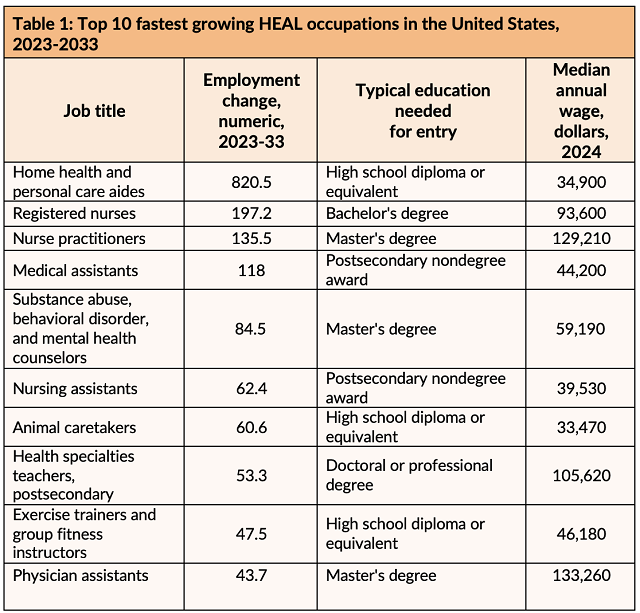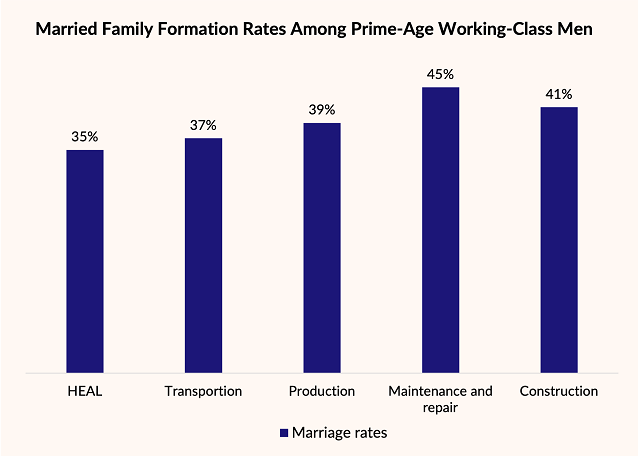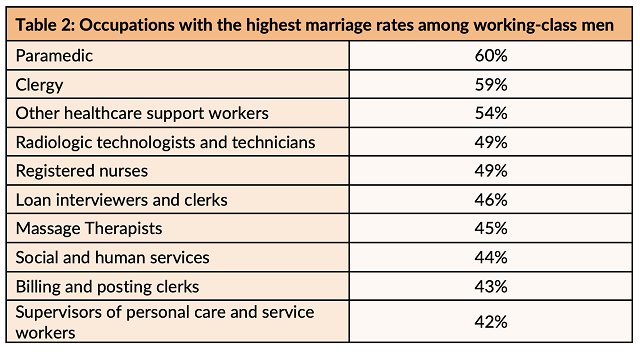Highlights
- A substantial portion of the decline in marriage and family formation rates among working-class men is likely explained by deteriorating job quality. Post This
- Many of the fastest growing HEAL jobs demand substantial postsecondary education. This presents a significant barrier for many working-class men. Post This
- Jobs in maintenance, repair, and other traditionally working-class male jobs had the highest rates of married family formation, while those in HEAL occupations had the lowest. Post This
Starting in the late 1970s, the U.S. economy underwent a sharp shift away from manufacturing, a sector that had long offered stable, well-paying jobs to men without college degrees—a group often identified as “working class.” As manufacturing declined, especially in regions like the Rust Belt that were hardest hit by deindustrialization, job growth concentrated in the service sector. In my hometown of Pittsburgh, for example, civic leaders responded to industrial decline by shifting their focus toward healthcare, education, and financial services. This economic transition created new types of employment but not ones evenly suited to the displaced workers. Many lifelong Pittsburghers felt abandoned by political leaders who seemed more focused on attracting new residents to the city’s growing industries than on supporting those who had lost their jobs.
This economic realignment has had cascading economic and social consequences for working-class Americans. From 1979 to 2019, real earnings for non-college-educated workers declined by 11%, even as median wages for college graduates increased by 15 percent. As well-paying jobs disappeared, married family formation among working-class Americans also plummeted. Between 1980 and 2021, the proportion of married men without a college degree declined by nearly 45 percent. In a recent report that I co-authored for the Institute for Family Studies (IFS), a substantial portion of this decline in marriage and family formation rates among working-class men is likely explained by deteriorating job quality. Improving family stability, then, depends in part on improving the economic prospects of this demographic.
Will HEAL Jobs Help Working-Class Men?
Many pundits have argued that we should focus on helping working-class Americans enter fast-growing service-sector jobs in fields like caregiving, healthcare support, education, and administration. Some scholars group these under the acronym “HEAL”—Health, Education, Administration, and Literacy. For instance, the fastest-growing job in the United States today is a home health aide, and three of the top 10 fastest-growing occupations fall under the HEAL category, including registered nurses and nurse practitioners.
However, HEAL fields remain largely female-dominated. While major efforts have been made to encourage women to enter traditionally male-dominated STEM (Science, Technology, Engineering, and Math) occupations, there has been relatively little investment in helping men enter HEAL fields. Richard Reeves of the American Institute for Boys and Men and others have called for a national initiative to recruit more men into these roles. The rationale is straightforward: HEAL jobs sometimes offer relatively stable, high-growth employment and opportunities for meaningful, community-oriented work.
Proponents argue that a concerted effort—through job training, incentives, and cultural messaging—could help reshape the trajectory of working-class men just as STEM efforts helped open new pathways for women. However, serious questions remain about whether HEAL jobs can meaningfully replace the kinds of employment that once sustained working-class male workers, both economically and socially.
Educational Access Is a Barrier
A core concern is educational access—specifically, whether HEAL jobs are good jobs for working-class men. Many of the fastest growing HEAL occupations over the next decade demand substantial postsecondary education. Table 1 lists the 10 fastest-growing HEAL jobs: half require at least a bachelor’s degree. This presents a significant barrier for many working-class men, for whom college is neither financially feasible nor personally compelling. These are not roles that typically allow for on-the-job learning or entry through accessible vocational pathways.

Even among HEAL jobs that do not require a four-year degree, wages are often very low. Roles such as personal care aides or medical assistants typically pay $35,000–$45,000 annually. As shown in Table 1, every job requiring less than a bachelor’s degree pays under $50,000 per year. For men trying to support a family—especially in high-cost regions—this is insufficient. Simply directing men into available HEAL jobs may therefore fail to address the deeper problem: the shortage of well-paying, family-supporting jobs for those without a college degree.
Men in HEAL Jobs Are Less Likely to Marry
In our new analysis of data from Current Population Survey (CPS) (2021-2024), we found that men in HEAL occupations are significantly less likely to marry and form families than men in more traditional, male-dominated working-class jobs. We compared married family formation (married with children in the home) rates among prime working-age men (45-54) without college degrees in HEAL occupations to those in industries that are male-dominated and are geared to working-class Americans. Those in maintenance, repair, and other traditionally working-class male occupations had the highest rates of married family formation, while those in HEAL occupations had the lowest.

Source: Current Population Survey (2021-2024)
The Type of Job Matters
This does not mean HEAL jobs are inherently “anti-family” or “anti-men.” Some HEAL roles do appear to support married family life. In Table 2, we rank HEAL occupations by their rates of married family formation. This variation across HEAL jobs suggests that the type of HEAL job matters a great deal. Some of these highest marriage rate jobs—like paramedics and radiation technologists—do involve technical training beyond high school but fall short of requiring a bachelor’s degree. They may offer better wages, more stable hours, greater autonomy, or stronger community respect—features that can make them more compatible with marriage and family life for working-class men.

At the same time, these findings also suggest that the mismatch between marriage and family formation across industries extends beyond formal job characteristics like wages and stability. Interestingly, many of the top HEAL jobs in terms of married family formation rates are male-dominated—such as paramedics and clergy. Cultural identity, gender norms, and the social meanings attached to certain kinds of work may also influence family formation. Some HEAL jobs may be seen by some men as more or less compatible with their notions of masculinity and family provision. Furthermore, it is worth noting that the cultures within these two particular fields promote growth in character virtues aligned with family life—such as dependability, responsibility, and service to others. These perceptions matter not only for recruitment into HEAL fields but also for broader patterns of relational stability and life planning.
A Better Strategy
Encouraging more working-class men to enter HEAL fields might be an important strategy to strengthen work and family life for many men, but it is no panacea. A serious strategy to address the intertwined crises of working-class male economic dislocation and declining family formation must go beyond simply promoting entry into available service-sector jobs. Policymakers and community leaders should prioritize expanding access to good jobs that provide a living wage, some degree of autonomy, status, honor, and viable pathways to family provision. Just as important, we must not overlook jobs that offer the structure and environment needed to cultivate the kind of character that also leads to success related to marriage and family. Some HEAL roles may meet this standard—but many likely do not.
A more effective approach would identify which HEAL jobs align most closely with the needs and values of working-class men, then invest in education, recruitment, and workplace design to make those roles more accessible and appealing. In this way, HEAL jobs could become not just viable employment options, but genuine vehicles for restoring economic dignity and strengthening family life in the working class.
Grant Martsolf is a professor at the University of Pittsburgh School of Nursing. He writes on issues related to class and well-being at his Substack newsletter “The Savage Collective.”















